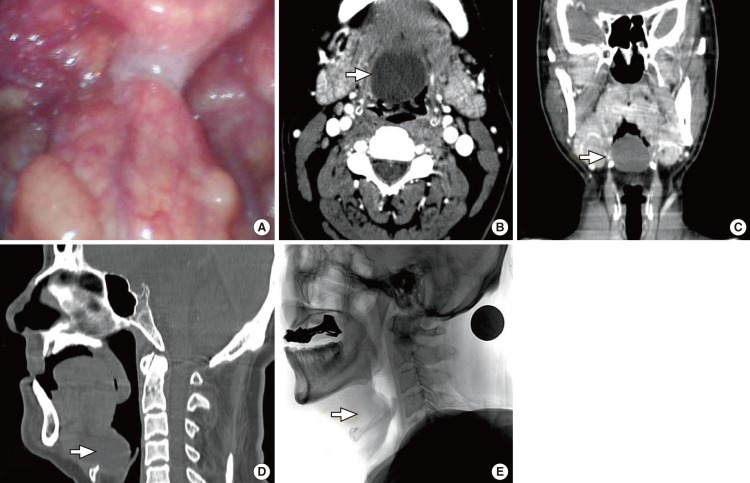Clin Exp Otorhinolaryngol.
2013 Sep;6(3):187-190.
A Thyroglossal Duct Cyst Causing Obstructive Sleep Apnea in Adult
- Affiliations
-
- 1Department of Otorhinolaryngology-Head and Neck Surgery, Seoul National University Bundang Hospital, Seoul National University College of Medicine, Seongnam, Korea.
- 2Department of Otorhinolaryngology-Head and Neck Surgery, Dankook University College of Medicine, Cheonan, Korea. jihunmo@gmail.com
Abstract
- Obstructive sleep apnea (OSA) is a common disorder. It usually results from the structural compromise of the upper airway. In patients with OSA, the obstruction predominantly occurs along the pharyngeal airway, and also a variety of tumors have been reported to cause such a condition. We present here the case of a thyroglossal duct cyst causing OSA in adult. This case demonstrates that thyroglossal duct cyst or some kind of mass lesions in the airway lesions should be considered in the differential diagnosis of OSA patients.
MeSH Terms
Figure
Reference
-
1. Friedman M, Ibrahim H, Joseph NJ. Staging of obstructive sleep apnea/hypopnea syndrome: a guide to appropriate treatment. Laryngoscope. 2004; 3. 114(3):454–459. PMID: 15091218.
Article2. Lee CH, Mo JH, Seo BS, Kim DY, Yoon IY, Kim JW. Mouth opening during sleep may be a critical predictor of surgical outcome after uvulopalatopharyngoplasty for obstructive sleep apnea. J Clin Sleep Med. 2010; 4. 6(2):157–162. PMID: 20411693.
Article3. Hockstein NG, Anderson TA, Moonis G, Gustafson KS, Mirza N. Retropharyngeal lipoma causing obstructive sleep apnea: case report including five-year follow-up. Laryngoscope. 2002; 9. 112(9):1603–1605. PMID: 12352671.
Article4. Picciotti PM, Agostino S, Galla S, Della Marca G, Scarano E. Aryepiglottic fold cyst causing obstructive sleep apnea syndrome. Sleep Med. 2006; 6. 7(4):389. PMID: 16713345.
Article5. Smadi T, Raza MA, Woodson BT, Franco RA. Obstructive sleep apnea caused by carotid body tumor: case report. J Clin Sleep Med. 2007; 8. 3(5):517–518. PMID: 17803016.
Article6. Barnes TW, Olsen KD, Morgenthaler TI. Obstructive lingual thyroid causing sleep apnea: a case report and review of the literature. Sleep Med. 2004; 11. 5(6):605–607. PMID: 15511710.
Article7. Veitch D, Rogers M, Blanshard J. Parapharyngeal mass presenting with sleep apnoea. J Laryngol Otol. 1989; 10. 103(10):961–963. PMID: 2584857.
Article8. Walshe P, Smith D, Coakeley D, Dunne B, Timon C. Sleep apnoea of unusual origin. J Laryngol Otol. 2002; 2. 116(2):138–139. PMID: 11827591.
Article9. Chen MF, Fang TJ, Lee LA, Li HY, Wang CJ, Chen IH. Huge supraglottic cyst causing obstructive sleep apnea in an adult. Otolaryngol Head Neck Surg. 2006; 12. 135(6):986–988. PMID: 17141104.
Article10. Henderson LT, Denneny JC 3rd, Teichgraeber J. Airway-obstructing epiglottic cyst. Ann Otol Rhinol Laryngol. 1985; Sep-Oct. 94(5 Pt 1):473–476. PMID: 4051405.
Article11. Dahm MC, Panning B, Lenarz T. Acute apnea caused by an epiglottic cyst. Int J Pediatr Otorhinolaryngol. 1998; 1. 42(3):271–276. PMID: 9466231.
Article12. Koeller KK, Alamo L, Adair CF, Smirniotopoulos JG. Congenital cystic masses of the neck: radiologic-pathologic correlation. Radiographics. 1999; Jan-Feb. 19(1):121–146. PMID: 9925396.13. Suh MW, Sung MW. Apnea spells in an infant with vallecular cyst. Ann Otol Rhinol Laryngol. 2004; 9. 113(9):765. PMID: 15453537.
Article14. Diaz MC, Stormorken A, Christopher NC. A thyroglossal duct cyst causing apnea and cyanosis in a neonate. Pediatr Emerg Care. 2005; 1. 21(1):35–37. PMID: 15643322.
Article15. Eom M, Kim YS. Asphyxiating death due to basal lingual cyst (thyroglossal duct cyst) in two-month-old infant is potentially aggravated after central catheterization with forced positional changes. Am J Forensic Med Pathol. 2008; 9. 29(3):251–254. PMID: 18725783.
Article16. Hanzlick RL. Lingual thyroglossal duct cyst causing death in a four-week-old infant. J Forensic Sci. 1984; 1. 29(1):345–348. PMID: 6699603.
Article17. Wu PY, Friedman M, Huang SC, Lin HC. Radiology quiz case 1: Adult lingual thyroglossal duct cyst (TGDC). Arch Otolaryngol Head Neck Surg. 2009; 7. 135(7):716. 718. PMID: 19620596.18. Sauvageau A, Belley-Cote EP, Racette S. Fatal asphyxia by a thyroglossal duct cyst in an adult. J Clin Forensic Med. 2006; Aug-Nov. 13(6-8):349–352. PMID: 17027318.
Article19. Fodor J 3rd, Malott JC, Colley DP, Walsh JK, Kramer M. Somnofluoroscopy. Radiol Technol. 1981; Sep-Oct. 53(2):105–109. PMID: 7339697.
- Full Text Links
- Actions
-
Cited
- CITED
-
- Close
- Share
- Similar articles
-
- Two Cases of Thyroglossal Duct Fistula
- A Case of Huge Lingual Tonsillar Hypertrophy Causing Obstructive Sleep Apnea in Adult
- Intra-thyroid Thyroglossal Duct Cyst: A Case Report
- A Case of Papillary Thyroid Carcinoma Arising in a Thyroglossal Duct Cyst with Complete Ectopic Thyroid Gland
- Effects of Menopause on Obstructive Sleep Apnea



